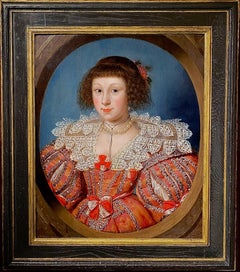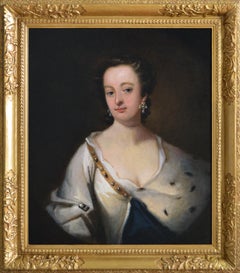Gilbert Jackson Art
to
1
Overall Width
to
Overall Height
to
1
1
1
1
1
1
1
1
1
8,816
2,808
1,655
1,313
1
1
Artist: Gilbert Jackson
Portrait of a Girl, 17th Century English School Old Masters Oil
By Gilbert Jackson
Located in London, GB
Gilbert Jackson
English Active: 1620 - 1650
Portrait of a Girl
Oil on panel, signed upper left and Inscribed upper right
Image size: 24 ½ x 20 inches
Contemporary style hand made...
Category
17th Century Old Masters Gilbert Jackson Art
Materials
Oil
Related Items
18th Century portrait oil painting of a lady in an ermine trimmed cloak
By Sir Godfrey Kneller
Located in Nr Broadway, Worcestershire
Circle of Sir Godfrey Kneller
Dutch, (1646-1723)
Portrait of a Lady in an Ermine Trimmed Cloak
Oil on canvas
Image size: 26.5 inches x 22.5 inches
Size including frame: 33.5 inches x 29.5 inches
A well-executed half-length portrait of a lady painted in a feigned oval, circle of Sir Godfrey Kneller. The use of a feigned oval was a device used in portraiture to give a sense of depth and add an intimacy to the painting, drawing your attention to the sitter.
The subject, posed without her wig in the undressed fashion of the day, wears a blue ermine trimmed blue cloak over a white silk robe...
Category
18th Century Old Masters Gilbert Jackson Art
Materials
Canvas, Oil
$7,122
H 33.5 in W 29.5 in D 2.25 in
19th century portrait painted in St Petersburg in 1819
Located in London, GB
Signed, inscribed and dated, lower right:
'Geo Dawe RA St Petersburgh 1819', also signed
with initials, lower centre: 'G D RA'; and signed and inscribed verso:
'Geo Dawe RA Pinxit 1819 St Petersburgh';
Also inscribed on the stretcher by Cornelius Varley with varnishing instructions.
Collections:
Private collection, UK, 2010
Literature:
Galina Andreeva Geniuses of War, Weal and Beauty: George Dawe...
Category
19th Century Old Masters Gilbert Jackson Art
Materials
Oil, Canvas
Portrait of a Gentleman in Doublet & Ruff c.1595; Elizabethan oil on copper
Located in London, GB
Portrait of an Elizabethan Gentleman in a Black Doublet c.1595
Manner of Hieronimo Custodis (died c.1593)
Oil on copper
Unsigned
This exquisite oil on copper portrait, painted around 430 years ago, is a splendid survival from the Elizabethan era - the golden age in England’s history, when Queen Elizabeth I was on the throne. It is a time that is sandwiched between two golden ages of English renaissance culture, the reigns of Henry VIII and Charles I. This period produced a style of painting quite unlike that anywhere else in Europe and one that deserves serious assessment. Just a couple of years after our portrait was painted, English painting developed on another course, driven mainly by the artists Marcus Gheeraerts the Younger and Isaac Oliver; they depicted a new mood that was pervading Elizabethan and Jacobean society, which was that of romantic melancholy. Elizabethan painting...
Category
16th Century Old Masters Gilbert Jackson Art
Materials
Copper
$7,328
H 14.18 in W 12.6 in D 1.19 in
Christ on the Cold Stone – After Jan Gossaert (Mabuse)
Located in Stockholm, SE
This striking devotional image, painted by a follower of Jan Gossaert, represents one of the most influential compositions of the Northern Renaissance: Christ on the Cold Stone, or C...
Category
16th Century Old Masters Gilbert Jackson Art
Materials
Oil, Wood Panel
Portrait of Gentleman Blue & Cloak, Portrait of Lady, Fine Carved Gilded frames
Located in London, GB
Portrait of a Gentleman with Blue Cloak and Portrait of a Lady in Russet Dress c.1697
Thomas Murray (1663-1735)
These fascinating portraits are exquisite examples of portraiture in ...
Category
17th Century Old Masters Gilbert Jackson Art
Materials
Oil, Canvas
$27,738
H 37.8 in W 33.47 in D 2.76 in
Asklepios and His Followers
Located in Stockholm, SE
This captivating work belongs to Elias Martin’s later period, characterized by his exploration of historical, biblical, and mythological themes. As Mikael Ahlund, Director of the Gus...
Category
1810s Old Masters Gilbert Jackson Art
Materials
Canvas, Oil
Portrait of Monsieur Aubert, a ceremonial portrait by Nicolas de Largillière
By Nicolas de Largillière
Located in PARIS, FR
Provenance :
Arnold S. Kirkeby (1901-1962)
Donated by Arnold S. Kirkeby to the Los Angeles County Museum of Art in 1955, where it remained until its sale at Sotheby's, New York on Ja...
Category
1720s Old Masters Gilbert Jackson Art
Materials
Oil
$120,000
H 64.57 in W 52.57 in
19th century Portrait of a lady, Priscilla Osborn, William Jacob Baer
Located in York, GB
PORTRAIT OF PRISCILLA, MRS WILLIAM OSBORN half length, oil on canvas,
WILLIAM JACOB BAER (1860-1941) housed in the original early 19th c gilt cavetto frame
The overall size being 94....
Category
19th Century Old Masters Gilbert Jackson Art
Materials
Oil
$3,282 Sale Price
20% Off
H 37.21 in W 32.29 in D 1.97 in
Fleur de Neige, Portrait de Mme Godillot
By Jan Van Beers
Located in Saint-Ouen-sur-Seine, FR
Fleur de Neige by Jan Van Beers, painted in July 1880, stands out for the delicacy of its depiction. This remarkable portrait depicts a woman dressed in a sumptuous white costume, ad...
Category
1880s Old Masters Gilbert Jackson Art
Materials
Oil
Oil Portrait of a Victorian Lady, c. 1850
Located in Chicago, IL
Painted in the 19th century, this exquisite miniature portrait wonderfully exemplifies realism in traditional oil painting. The small artwork is painted in the conventional portraiture style of the Old Masters, and achieves soft realism with fine brushwork and a subdued, neutral palette. The half length portrait depicts a fine Victorian woman dressed in all black with a delicate lace collar and bonnet. She wears a ruby broach...
Category
Mid-19th Century Old Masters Gilbert Jackson Art
Materials
Oil
18th century French Old Master Portrait of a woman in oriental costume
Located in Aartselaar, BE
French 18th century old master portrait of a majestic lady dressed "à la Turque"
The sitter at the viewer with a kind and enigmatic smile and twinkling eyes. She looks elegant and kind, yet also has an intelligent and determined aura, reflecting the character of someone who is in charge of her own life and destiny.
De Silvestre paid great attention to her spectacular outfit, which is striking in its portrayal of the sumptuous fabrics and their decorative richness. She is wearing a luxurious royal blue robe à la...
Category
1740s Old Masters Gilbert Jackson Art
Materials
Canvas, Oil
$21,934
H 31.89 in W 25.6 in D 0.4 in
Portrait of a Young Prince, 19th c., by Mystery Artist
Located in New York, NY
Mystery Artist
Untitled (Young Prince), c. 1800-1900
Oil on canvas
16 x 13 in.
Framed: 23 x 19 1/2 x 2 in.
Category
19th Century Old Masters Gilbert Jackson Art
Materials
Canvas, Oil
Gilbert Jackson art for sale on 1stDibs.
Find a wide variety of authentic Gilbert Jackson art available for sale on 1stDibs. You can also browse by medium to find art by Gilbert Jackson in oil paint, paint and more. Much of the original work by this artist or collective was created during the 18th century and earlier and is mostly associated with the Old Masters style. Not every interior allows for large Gilbert Jackson art, so small editions measuring 20 inches across are available. Customers who are interested in this artist might also find the work of Sir Godfrey Kneller, Flemish School, 17th Century, and Jean-Baptiste Monnoyer. Gilbert Jackson art prices can differ depending upon medium, time period and other attributes. On 1stDibs, the price for these items starts at $92,025 and tops out at $92,025, while the average work can sell for $92,025.


